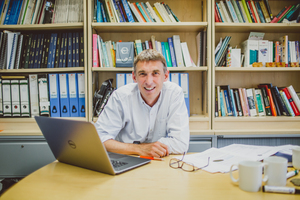David Gavaghan

Professor David Gavaghan
Biography
I received my undergraduate degree in Mathematics from Durham University in 1986. I then moved to the University of Oxford, where I was awarded an MSc in Numerical Analysis and Mathematical Modelling in 1987, followed by a DPhil in the Development of Parallel Numerical Algorithms in 1991. I have subsequently worked in the field of Mathematical and Computational Modelling, establishing and leading the Computational Biology Group, based principally within Oxford's Department of Computer Science. I was appointed Professor of Computational Biology in 2004. I have supervised thirty DPhil projects to completion, and I am currently involved with the supervision of a further six.

In 2002, I was awarded substantial EPSRC funding to establish and direct the Life Science Interface Doctoral Training Programme. This innovative and four-year DPhil programme was designed and individually tailored to provide comprehensive training in the application of techniques, taken from the mathematical and physical sciences, to cutting-edge research in the biomedical and life sciences. Following the success of the initial programme, the Rex Richards Building now houses our Doctoral Training Centre in the heart of the University's South Parks Road science campus. Collectively, over £60 million in RCUK funding and over £10 million from industrial contributors has allowed us to offer a range of six focused programmes: Systems Biology, Systems Approaches to Biomedical Science, Synthetic Biology, Interdisciplinary Bioscience, Synthesis for Biology and Medicine, and Biomedical Imaging. Around forty studentships are available annually, across a range of interdisciplinary areas and including a small number available to international students. Over five hundred students have enrolled in a DTC programme to date; graduates have gone on to successful careers in industrial and academic research, with a large proportion undertaking entrepreneurial activities.
I have several other roles within the University, including acting as Director of Graduate Studies for the Mathematical, Physical and Life Sciences Division. I also chair the Department of Computer Science's Equality and Diversity Committee; in recognition of our commitment to gender equality initiatives, the department gained a Bronze Athena SWAN award in April 2015. I am a fellow of New College.
In my free time, I enjoy running and coaching my son's football team.
Interests
All of my research is interdisciplinary and involves application of mathematical and computational techniques to problems in biomedicine. My core research revolves around the modelling of physiological and biological systems and associated measurement techniques: current areas of focus include the mammalian heart, tumour development, and electrochemical measurement techniques.
Starting with my own DPhil research, the computational complexity of these research problems has resulted in a long-standing interest in the use of state-of-the-art computing facilities, and development of the necessary computational infrastructure to support the research scientist. This has led to a strong involvement in the UK e-Science programme, through projects such as the EPSRC e-Science Pilot Project in Integrative Biology, and the BBSRC-funded e-Science project, IntBioSim.
A strong emphasis is placed on solving real-world problems, and providing meaningful and practical help to scientific co-workers. All of my work is therefore conducted in collaboration with internationally-leading clinical and experimental groups, both within in the UK and overseas. My current sources of funding include EPSRC, BBSRC, EU Framework 7, and industrial sponsors such as Fujitsu, GE Healthcare, Microsoft Research, GSK and AstraZeneca.
Projects
2020 Science is a collaborative research programme, based at the University of Oxford, University College London, and Microsoft Research, Cambridge. The emphasis is on the development of a new generation of future scientific leaders: highly computational natural scientists, able to tackle fundamental problems with novel approaches. The computational modelling required under this remit ranges from molecules to systems to organisms to ecosystems, and the interaction of each with their environment. To keep up-to-date with the project, the 2020 Science programme operates a mailing list.
Chaste (Cancer, Heart and Soft Tissue Environment) is an open source C++ library for simulation of the mathematical models developed for multi-scale, computationally demanding problems arising in biology and physiology. Initially driven by two applications, cardiac electrophysiology and cancer development, Chaste is constantly evolving and is now being applied to a far wider range of problems. The code provides modules for handling common scientific computing components, such as meshes and solvers for ordinary and partial differential equations (ODEs/PDEs). Re-use of these components avoids the need for researchers to ‘re-invent the wheel’ with each new project, accelerating the rate of progress in new applications. You may ask questions on the Chaste Users' Mailing List.
Selected Publications
-
Hierarchical Bayesian inference for ion channel screening dose−response data
RH Johnstone‚ R Bardenet‚ DJ Gavaghan and GR Mirams
In Wellcome Open Research. Vol. 1. Pages 6. 2016.
Details about Hierarchical Bayesian inference for ion channel screening dose−response data | BibTeX data for Hierarchical Bayesian inference for ion channel screening dose−response data | DOI (10.12688/wellcomeopenres.9945.1) | Link to Hierarchical Bayesian inference for ion channel screening dose−response data
-
Uncertainty and variability in models of the cardiac action potential: can we build trustworthy models?
RH Johnstone‚ ET Chang‚ R Bardenet‚ TP de Boer‚ DJ Gavaghan‚ P Pathmanathan‚ RH Clayton and GR Mirams
In Journal of Molecular and Cellular Cardiology. Vol. 96. Pages 49−62. 2016.
Details about Uncertainty and variability in models of the cardiac action potential: can we build trustworthy models? | BibTeX data for Uncertainty and variability in models of the cardiac action potential: can we build trustworthy models? | DOI (10.1016/j.yjmcc.2015.11.018)
-
Cardiac Tissue Slices: Preparation‚ Handling‚ and Successful Optical Mapping
K Wang‚ P Lee‚ GR Mirams‚ P Sarathchandra‚ T Borg‚ DJ Gavaghan‚ P Kohl and C Bollensdorff
In American Journal of Physiology: Heart and Circulatory Physiology. Vol. 308. Pages H1112−H1125. 2015.
Details about Cardiac Tissue Slices: Preparation‚ Handling‚ and Successful Optical Mapping | BibTeX data for Cardiac Tissue Slices: Preparation‚ Handling‚ and Successful Optical Mapping | DOI (10.1152/ajpheart.00556.2014) | Link to Cardiac Tissue Slices: Preparation‚ Handling‚ and Successful Optical Mapping
